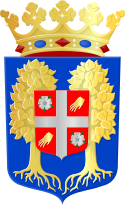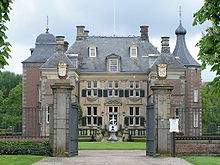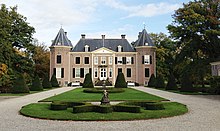Hof van Twente
 flag |
 coat of arms |
| province |
|
| mayor | Ellen Nauta-van Moorsel ( CDA ) |
| Seat of the municipality | Goor |
|
Area - land - water |
215.44 km 2 213.18 km 2 2.26 km 2 |
| CBS code | 1735 |
| Residents | 34,952 (Jan 31, 2019) |
| Population density | 162 inhabitants / km 2 |
| Coordinates | 52 ° 15 ′ N , 6 ° 42 ′ E |
| Important traffic route |
|
| prefix | 0547, 074 |
| Postcodes | 7470-7479, 7490-7499 |
| Website | Homepage of Hof van Twente |
Hof van Twente ( ) is a municipality in the Dutch province of Overijssel .
places
The following places are in the municipality (the most important are in italics ):
- Delden (about 7000 inhabitants)
- Diepenheim (around 2700 inh.)
- Goor , seat of the municipal administration, has around 12,250 inhabitants
- Markelo (approx. 7600 pop.)
- Azelo
- Bentelo (around 1500 inh.)
- Hengevelde (around 2100 inh.)
- and some smaller towns.
Stad Delden, Diepenheim, Goor, Markelo and Ambt Delden were independent parishes that were incorporated into the new parish in 2001.
Location and economy
The municipality is located southwest of Almelo , northeast of the Achterhoek ( Gelderland province ) and southeast of Rijssen-Holten , in the middle of the Overijssel province. Goor and Delden have asbestos cement, metal and plastics industries. Everywhere in the municipality, which is crossed by several streams, there are small forests, beautiful country estates, old water mills and small castles. Many tourists visit this rural area. They live in small hotels, holiday homes and on campsites and even farms. Agriculture is also important, and there is a lot of small business related to it too.
history
Goor
Goor ( Dutch : Schlick, Tiefland, Dreck) received city rights in 1263. The stewardess of Twente, who administered this area on behalf of the Utrecht prince-bishop , resided in Goor in the late Middle Ages . Several castles were built in the area, including Haus Heeckeren 1412, which has been a monastery since 1899. Goor had a small port on the Regge River , but when the Twenthe Canal was completed in 1936, an industrial port was established there.
The cement factory that produces asbestos cement brought many problems to Goor. For decades, everyone was allowed to use production residues from the company free of charge to create roads and garden paths. That this material contains carcinogenic asbestos particles was only found out in Goor around 1990. As a result, a large part of the city had to be remediated. Some former employees who were diagnosed with cancer while working at Eternit and their descendants brought legal proceedings against the company between 1990 and 2006, with varying degrees of success.
Delden
Delden received city rights in 1333. Its round town center was fortified with earth walls for several centuries. Twickel Castle is located next to the village . In its current form, it mainly dates from the 17th and 19th centuries. It can only be viewed from the outside, but the parks and forests of the 60 km² country estate are partly freely accessible. From 1347 to 1580 it was owned by the von Twickel family , from 1580 by von Raesfeld and from 1714 by Van Wassenaer , through the marriage of Marie Cornélie van Wassenaer Obdam (1799–1850) it came to the van Heeckeren van Kell family, who took the name van Heeckeren van Wassenaer. Baroness Marie Amélie van Heeckeren van Wassenaer, b. Countess van Aldenburg Bentinck (1879–1975), brought the castle and estate into a foundation in 1953, which is administered by her great-nephew Christian Graf zu Castell-Rüdenhausen (1952–2010) and now by his heirs.
In 1886, table salt was discovered in the soil of Schloss Twickel . That led to the still operating salt production in Hengelo . Markelo were grave mounds from the prehistory discovered.
Attractions
Everywhere in Hof van Twente (Twente Garden) you can go hiking or cycling, because there are small forests, beautiful country estates, old water mills and small castles in the municipality, which is crossed by several streams. Many tourists therefore visit this rural area. They live in small hotels, holiday homes and on campsites or farms.
Warmelo Castle near Diepenheim was built in 1315 and then destroyed and rebuilt several times. In 1952 the Prince Consort Bernhard zur Lippe-Biesterfeld bought it for his mother, Princess Armgard , who lived there until her death in 1971. After that it changed hands several times. The gardens, some in the French and some in the English style, are among the most beautiful in the Netherlands. The park can be visited from May to early October.
Weldam Castle between Markelo and Goor was built on the site of an older moated castle in the middle of the 17th century in the Renaissance style from Bentheim sandstone with ornaments, and at the end of the 17th century it was supplemented by two side wings, side buildings and the monumental courtyard gate. At that time owned by the Ripperda , it was inherited by the Wassenaer in 1751 , by marriage to the Counts Aldenburg- Bentinck in 1877 and by marriage to the Counts zu Solms -onnenwalde in 1914. The current owner is Alfred Graf zu Solms-Sonnenwalde. Of this castle, too, only the beautiful gardens - against payment - and the forests - free of charge - can be visited.
Huis Diepenheim , first mentioned in 1177, was built in its current form from 1648 by Bernard Bentinck (1597–1668), in whose family it remained until 1814. It has belonged to the Barons De Vos van Steenwijk since 1925 and is privately owned.
Nijenhuis Castle near Diepenheim was a seat of feudal people of the Utrecht bishops, came to the Van Beckum family in the middle of the 15th century and remained with their descendants until 1788 through multiple female inheritance. It was acquired by Rutger Jan Schimmelpenninck in 1799 . It still belongs to Count Schimmelpenninck to this day . The nearby Westerflier house has been part of the property since 1854.
The late Gothic St. Blasius Church (15th century) is in Delden and can be visited. Delden also has a museum dedicated to table salt (Zoutmuseum).
A 148-meter high television tower has been located in Markelo since 1959.
Partner communities
In 1980 the former municipality of Markelo established a partnership with the Lower Saxony joint municipality of Spelle . Markelo has merged into Hof van Twente, but the partnership is still maintained.
Daughters and sons of the church
- Albertus Boom (* 1938), racing cyclist
- Tommy Wieringa (* 1967), writer
- Ellen Jansen (* 1992), soccer player
Web links
- Website of the municipality (Dutch)
- Website of Twickel Castle (Dutch)
- Weldam Castle website (German, Dutch, English)
- Website of the Salt Museum Delden (Dutch)
- Warmelo Castle website (Dutch, German)
Individual evidence
- ↑ Bevolkingsontwikkeling; regio per maand . In: StatLine . Centraal Bureau voor de Statistiek (Dutch)
- ↑ Entry about the partnership on the homepage of the Samtgemeinde Spelle.Retrieved on April 16, 2019, 5:44 pm






